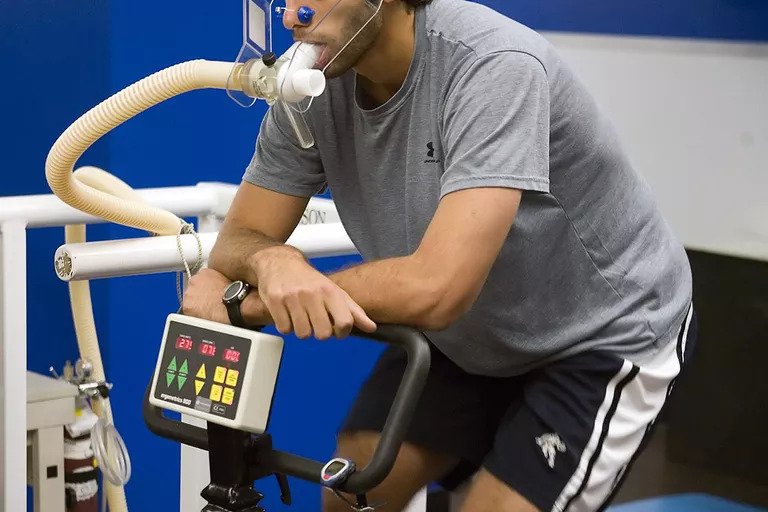
VO2 max, also known as maximal oxygen uptake, is the measurement of the maximum amount of oxygen a person can utilize during intense exercise. It is a common measurement used to establish the aerobic endurance of an athlete prior to or during the course of training. It is one of several tests used to determine an athlete's cardiovascular fitness and performance capacity.
VO2 max is measured in milliliters of oxygen used in one minute per kilogram of body weight (mL/kg/min). It is based on the premise that the more oxygen an athlete consumes during high-level exercise, the more the body will generate adenosine triphosphate (ATP) energy in cells. ATP is often referred to as the "molecular unit of currency" of intracellular energy,
VO2 max should not be confused with the lactate threshold (LT) testing, which refers to the point during high-intensity exercise where lactate builds up in the muscles faster than it can be removed.
VO2 max is typically conducted in a sports performance lab. It is most often graded, meaning that the intensity is carefully calibrated and increased over time.
Either a treadmill or stationary bicycle may be used. Prior to the test, you would be outfitted with a face mask that is connected to a machine which can analyze your respiratory rate and volume alongside the concentration of oxygen and carbon dioxide in inhaled and exhaled air. A heart strap would be worn around your chest to measure your heart rate.?
The test usually takes between 10 and 20 minutes. To prepare for the test, you would need to:
VO2 max is reached when your oxygen consumption remains at a steady state despite an increase in the workload. It is at this plateau that the athlete moves from aerobic metabolism to anaerobic metabolism. From there, it is usually not long before muscle fatigue sets in and forces the athlete to stop exercising.?
The VO2 max values can be used to establish your baseline fitness level before the start of a training program and used thereafter to track your progress.
The algorithm used to calculate your score can vary, although the one widely used for commercial applications is called the FirstBeat method. Introduced in 2012, the FirstBeat method measures your VO2 max value based on a linear relationship between oxygen consumption and running (or cycling) speed.
Other methods of calculation include the Cooper test, designed for the U.S. Air Force in the 1960s, and the Uth-Sørensen-Overgaard-Pedersen estimation, which factors in your resting heart rate (RHR) and maximum heart rate (MHR).
Broadly speaking, VO2 max values are characterized in men and women as follows:
| VO2 Max Norms for Men | ||||||
|---|---|---|---|---|---|---|
| Age | Very Poor | Poor | Fair | Good | Excellent | Superior |
| 13-19 | Under 35.0 | 35.0-38.3 | 38.4-45.1 | 45.2-50.9 | 51.0-55.9 | Over 55.9 |
| 20-29 | Under 33.0 | 33.0-36.4 | 36.5-42.4 | 42.5-46.4 | 46.5-52.4 | Over 52.4 |
| 30-39 | Under 31.5 | 31.5-35.4 | 35.5-40.9 | 41.0-44.9 | 45.0-49.4 | Over 49.4 |
| 40-49 | Under 30.2 | 30.2-33.5 | 33.6-38.9 | 39.0-43.7 | 43.8-48.0 | Over 48.0 |
| 50-59 | Under 26.1 | 26.1-30.9 | 31.0-35.7 | 35.8-40.9 | 41.0-45.3 | Over 45.3 |
| 60+ | Under 20.5 | 20.5-26.0 | 26.1-32.2 | 32.3-36.4 | 36.5-44.2 | Over 44.2 |
| VO2 Max Norms for Women | ||||||
|---|---|---|---|---|---|---|
| Age | Very Poor | Poor | Fair | Good | Excellent | Superior |
| 13-19 | Under 25.0 | 25.0-30.9 | 31.0-34.9 | 35.0-38.9 | 39.0-41.9 | Over 41.9 |
| 20-29 | Under 23.6 | 23.6-28.9 | 29.0-32.9 | 33.0-36.9 | 37.0-41.0 | Over 41.0 |
| 30-39 | Under 22.8 | 22.8-26.9 | 27.0-31.4 | 31.5-35.6 | 35.7-40.0 | Over 40.0 |
| 40-49 | Under 21.0 | 21.0-24.4 | 24.5-28.9 | 29.0-32.8 | 32.9-36.9 | Over 36.9 |
| 50-59 | Under 20.2 | 20.2-22.7 | 22.8-26.9 | 27.0-31.4 | 31.5-35.7 | Over 35.7 |
| 60+ | Under 17.5 | 17.5-20.1 | 20.2-24.4 | 24.5-30.2 | 30.3-31.4 | Over 31.4 |
The average sedentary male will achieve a VO2 max of approximately 35 to 40 mL/kg/min. The average sedentary female will score a VO2 max of between 27 an 30 mL/kg/min.
These scores can improve with training but may be limited by certain factors. Among them:
Higher VO2 max scores are associated with certain endurance sports, most specifically cycling, rowing, distance running, and cross-country skiing. Tour de France winner Miguel Indurain's VO2 max was reported at 78 mL/kg/min during the peak of his conditioning, while cross-country skier Bjørn Dæhlie reportedly achieved a VO2 max of 96 mL/kg/min.?